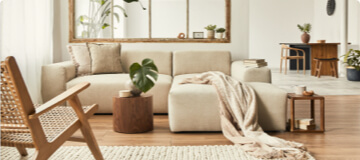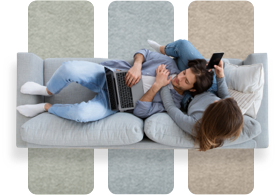Bamboo flooring can be a cost-effective way to achieve the look and feel of traditional hardwood floors. In fact, bamboo flooring can be harder wearing than many other hardwood timbers and is far more resilient to water damage. Bamboo is actually a type of grass, making compressed bamboo flooring resistant to mould, water and mildew. But resistance to water is not the same as being completely immune to water damage. If you’re thinking of using bamboo flooring in your home, here are some important considerations to keep in mind when it comes to water and water damage.
Bamboo flooring is water-resistant
The water-resistant properties of bamboo flooring mean that you don’t have to panic if water or fluids are spilt on your new floors. Simply wipe up the mess and your floor will be as good as new. Problems arise when water is left to sit for extended periods of time, an ongoing problem in bathrooms and also something to consider in areas prone to flooding. Water-damaged bamboo flooring will warp and disfigure. Unfortunately, unlike scratches and discolouration, water damage is a permanent problem and can’t be fixed by refinishing the surface of the flooring.
Constant exposure to high humidity can also cause bamboo flooring to plump and splashes of water that are not cleaned up swiftly and are left to dry can also cause damage and discolouration.
Bamboo flooring in bathrooms
Bamboo flooring may be an option for a private ensuite bathroom if you’re careful to use mats in areas that will be exposed to water and clean up splashes and spills. You will also need to waterproof the flooring and redo periodically every few years. Another option is to go for a half bath look and tile around the sink, shower or bath and use bamboo flooring around the tiles.
If you’re considering bamboo flooring for a family bathroom or any bathroom used by children, it’s probably not the best option even with waterproofing.
Waterproofing your bamboo flooring
Applying a polyurethane finish to your flooring, along with ensuring seams are glued and the expansion gap is waterproofed, is strongly recommended if you’re considering bamboo flooring in areas where water could be an issue. You’ll need to redo the waterproof finish every few years to ensure your flooring remains impregnable to water.
Care and maintenance of your floors
Bamboo flooring should be swept or vacuumed regularly to remove dirt particles, which scratch and damage the surface of the flooring and make it less resistant to water. Mop using a non-wax, non-alkaline cleaner designed for hardwood or bamboo floors. Water pooling from an overly wet mop can be problematic so avoid this or go over your floors with a dry mop afterwards.
Other considerations are pet bowls and plants. Place your pet’s food and water bowls on a chamois towel to absorb water spills and slobber. Replace regularly to avoid a damp cloth sitting on the bamboo flooring for extended periods of time. Use plant stands to prevent plant pot bases coming into direct contact with the flooring and be sure to wipe up any water spills immediately.
Advice from the experts
If you’re considering bamboo flooring, have a chat with one of the experts at Ashmore Carpets . They’ll help guide you on the right flooring for every room in your house and are full of hints and tips to help keep your bamboo flooring looking brand new for longer.





